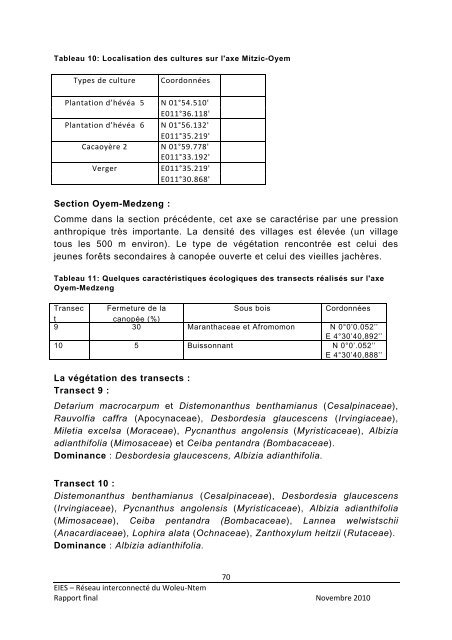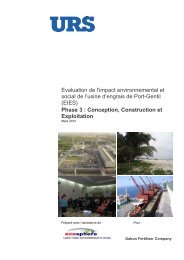En rapport avec le Réseau Interconnecté du Woleu-Ntem - Coface
En rapport avec le Réseau Interconnecté du Woleu-Ntem - Coface
En rapport avec le Réseau Interconnecté du Woleu-Ntem - Coface
Create successful ePaper yourself
Turn your PDF publications into a flip-book with our unique Google optimized e-Paper software.
Tab<strong>le</strong>au 10: Localisation des cultures sur l'axe Mitzic-Oyem<br />
Types de culture<br />
Coordonnées<br />
Plantation d’hévéa 5 N 01°54.510'<br />
E011°36.118'<br />
Plantation d’hévéa 6 N 01°56.132'<br />
E011°35.219'<br />
Cacaoyère 2 N 01°59.778'<br />
E011°33.192'<br />
Verger E011°35.219'<br />
E011°30.868'<br />
Section Oyem-Medzeng :<br />
Comme dans la section précédente, cet axe se caractérise par une pression<br />
anthropique très importante. La densité des villages est é<strong>le</strong>vée (un village<br />
tous <strong>le</strong>s 500 m environ). Le type de végétation rencontrée est celui des<br />
jeunes forêts secondaires à canopée ouverte et celui des vieil<strong>le</strong>s jachères.<br />
Tab<strong>le</strong>au 11: Quelques caractéristiques écologiques des transects réalisés sur l'axe<br />
Oyem-Medzeng<br />
Transec Fermeture de la<br />
Sous bois Cordonnées<br />
t<br />
canopée (%)<br />
9 30 Maranthaceae et Afromomon N 0°0’0.052’’<br />
E 4°30’40,892’’<br />
10 5 Buissonnant N 0°0’.052’’<br />
E 4°30’40,888’’<br />
La végétation des transects :<br />
Transect 9 :<br />
Detarium macrocarpum et Distemonanthus benthamianus (Cesalpinaceae),<br />
Rauvolfia caffra (Apocynaceae), Desbordesia glaucescens (Irvingiaceae),<br />
Mi<strong>le</strong>tia excelsa (Moraceae), Pycnanthus ango<strong>le</strong>nsis (Myristicaceae), Albizia<br />
adianthifolia (Mimosaceae) et Ceiba pentandra (Bombacaceae).<br />
Dominance : Desbordesia glaucescens, Albizia adianthifolia.<br />
Transect 10 :<br />
Distemonanthus benthamianus (Cesalpinaceae), Desbordesia glaucescens<br />
(Irvingiaceae), Pycnanthus ango<strong>le</strong>nsis (Myristicaceae), Albizia adianthifolia<br />
(Mimosaceae), Ceiba pentandra (Bombacaceae), Lannea welwistschii<br />
(Anacardiaceae), Lophira alata (Ochnaceae), Zanthoxylum heitzii (Rutaceae).<br />
Dominance : Albizia adianthifolia.<br />
70<br />
EIES – <strong>Réseau</strong> interconnecté <strong>du</strong> Wo<strong>le</strong>u‐<strong>Ntem</strong><br />
Rapport final Novembre 2010






